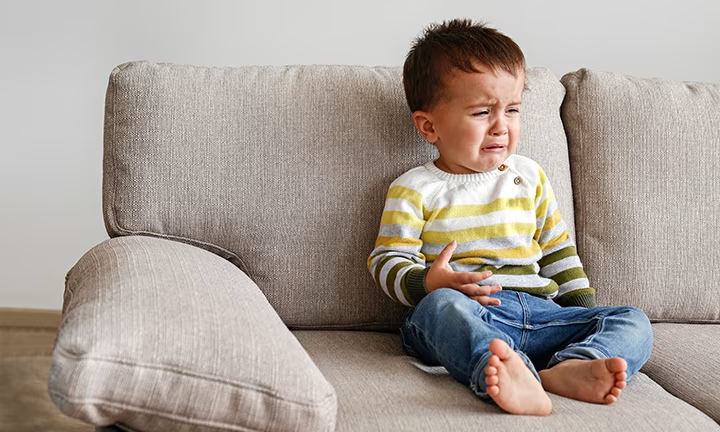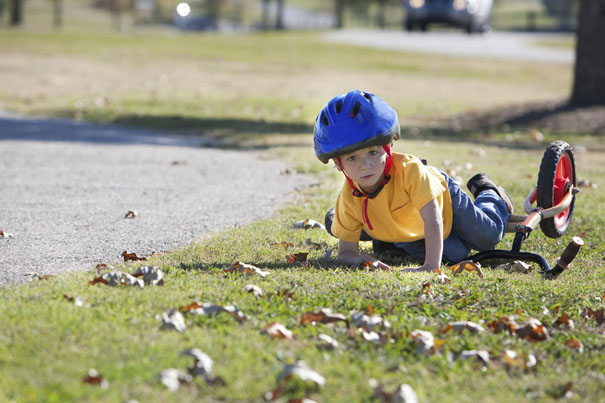
What's Causing Your Toddler's Stomach Pain?
Key Takeaways
If your toddler complains of stomach pains or tummy aches, they’re not alone. Stomach pain in kids is very common and is frequently the reason parents take their children to the doctor. Luckily, most stomachaches in kids don’t need medical intervention, but if your child complains of stomach pain every day, it might be something more serious. To help you know when to call your child’s healthcare provider, we’ve compiled the most common reasons for toddler tummy aches.
Types of Stomach Pain in Kids
Kids get tummy aches—they’re a normal part of toddler life. However, stomach pain presents itself in different ways, and these may sometimes provide clues to what’s causing the problem. The different types of stomach pain in kids include:
Kids might not be able to alert you to their stomach pains, so they may rely on you to notice the common symptoms of a tummy ache. Besides trying to understand if the pain is generalized, localized, or cramp-like, look for these typical signs of tummy problems:
If your toddler exhibits any of those symptoms, they probably have a tummy ache or pain.
In Summary
Different types of stomach pain in kids can offer clues to what’s going on. Generalized pain is common with digestive issues and viruses, whereas localized pain usually indicates a problem in a specific area, such as a stomach ulcer or appendicitis. Cramp-like pain could be due to gas and bloating and is typically followed by diarrhea.
Possible Causes of Stomachache in Kids
Stomach pain in children is normal and not usually something to worry about, which can give you a little peace of mind when you need it most! Of course, it’s always a good idea to consult your child’s healthcare provider, who can determine what’s behind your toddler’s tummy aches and address any questions or concerns. Here’s an overview of some of the most common causes of stomach pain in kids along with tips to help you know when it’s serious and may need medical attention.
Constipation
Of all the digestive issues that lead to kids’ stomach pain, constipation is the most common culprit. A child who is constipated may have infrequent bowel movements or have hard, dry stools. When this condition occurs in a toddler, it’s often due to what they’re eating (or not eating enough of) or it may crop up during potty training.
With time and encouragement, your little one will eventually enjoy a variety of fiber-rich foods and become comfortable with using the toilet. Other causes of constipation that might lead to kids’ stomach pain include
Contact your toddler’s healthcare provider if your child’s constipation lasts more than two weeks or if your child complains of stomach pain daily, has blood in the stool, has a fever, and/or has a loss of appetite.
In Summary
Constipation is the most common cause of stomach pain in kids, typically occurring when potty training and transitioning to new foods. Other causes of constipation include stress, food allergies, medications, and underlying health conditions.
Food Allergies and Intolerances
Food allergies, intolerances, or sensitivities can also cause tummy aches in toddlers. Among the most common allergy-producing foods are milk, eggs, soy, wheat, tree nuts, fish, and shellfish. If your little one has any intolerances, sensitivities, or allergies to food, they may experience stomach pain, including gas, bloating, indigestion, and diarrhea. Keep in mind that a food intolerance or sensitivity is not the same as a food allergy. The former doesn’t initiate an immune response but can still cause stomach pain in kids. If your child has a food allergy, you will probably notice other symptoms besides a tummy ache, and some can be quite serious, such as trouble breathing or lightheadedness. Talk to your child’s healthcare provider if you have any concerns about food allergies or if your toddler has consistent stomach pain after eating certain foods. Call 911 or go to the emergency room if your child exhibits any serious symptoms of a food allergy, such as swelling, trouble breathing, or loss of consciousness.
Stomach Flu or Food Poisoning
Sometimes, stomach pain in kids comes from “stomach flu,” a common term for viral gastroenteritis. Other times, it can be due to food poisoning. Both can cause cramp-like or generalized stomach pain, diarrhea, and vomiting. Fortunately, symptoms don’t typically persist longer than 48 hours, so your little one will likely make a quick recovery. Vomiting can last 24 hours or more when it’s the stomach flu but shouldn’t be longer than 12 hours in the case of food poisoning. Contact your child’s healthcare provider if symptoms persist or your toddler has bloody stool, a pounding heartbeat, or diarrhea and a fever over 101 degrees Fahrenheit, and watch for signs of dehydration.
Strep Throat or Mononucleosis
Other illnesses can cause abdominal pain in children, including strep throat and mononucleosis (a.k.a. “mono”). The most common symptoms of strep throat are a fever, sore throat, and swollen tonsils and neck glands. But strep throat also can cause other symptoms in toddlers, such as stomach pains, usually in the lower abdomen. Contact your child’s healthcare provider if you suspect your toddler has strep throat, which is most often treated with antibiotics. As for mono, the most common symptoms are very similar to those of strep throat (fever, swollen neck glands, and a sore throat), but mono also cause your toddler to have an upset stomach. Mono typically leads to localized pain, so ask your little one where it hurts. If your child has pain in the left side of the abdomen, it could be mono-induced swelling in the liver or spleen. Although mono is pesky and can linger for weeks, symptoms usually go away on their own with lots of rest. Still, contact your child’s healthcare provider if you suspect mono. To protect the spleen and liver, the provider may recommend only light activity and play for your child until the stomach pain subsides.
In Summary
Kids can also experience stomach pain if they have food allergies, food poisoning, the stomach flu or another viral illness, or an illness like strep throat or mono. Your child’s healthcare provider can help you take care of your toddler’s tummy ache in any of these cases. For example, strep throat will require antibiotics, whereas food allergies may need tests or emergency medicine.
Stress and Anxiety
Stress and anxiety can also trigger stomach pains in kids (along with constipation, as mentioned above). When your toddler has an upset stomach but doesn’t show symptoms like cramping, diarrhea, vomiting, or other signs of an infection, consider what’s going on in their life. For example, kids may experience stress when
Children might feel stressed or anxious and experience abdominal pain for other reasons and in other situations, too. Try to find out what’s bothering your child and why they’re experiencing these difficult feelings. Your toddler’s healthcare provider can help you identify the problem and suggest ways to help reduce and manage the stress. These may include dietary changes, getting more sleep, increasing the amount of time spent in play and physical activity, and doing more fun things as a family.
Tip
Not all young children want (or know how) to talk about their feelings. Encourage your little one to share by initiating conversation with a toy or by acting out feelings with a game.
Appendicitis
Appendicitis is very rare in children under 3 years and uncommon for kids under 5 years, but it’s still helpful to know the symptoms. If your child has a mild fever and stomach pain around the belly button, these are the two initial signs of appendicitis. Although it may seem like a minor tummy ache at first, appendicitis eventually causes worsening pain in the lower right side of the belly. It’s best to contact child’s healthcare provider ASAP if you suspect appendicitis. If the appendix swells too much and bursts, it can cause a more serious bacterial infection. Signs of a ruptured appendix in a child include a high fever of 104 degrees Fahrenheit and stomach pain moving across the belly.
Henoch-Schonlein Purpura
Perhaps you’ve never heard of Henoch-Schonlein purpura (a.k.a. IgA vasculitis), as it’s not especially common. However, this condition is most likely to affect kids between the ages of 2 and 6 and can cause stomach pain. The most telling sign is a rash across the bottom, legs, and feet, but the illness also causes tummy aches and digestive problems. Henoch-Schonlein purpura tends to go away on its own, but it’s still a good idea to contact your child’s healthcare provider if a rash develops. The illness can impact the kidneys and cause more severe digestive issues.
Home Remedies for Stomach Pain in Kids
Although a few possible reasons for your toddler’s upset stomach require a call to their healthcare provider (as mentioned above), you may wonder what to give your little one at home, especially when they’re experiencing pain at night. Luckily, there are a few remedies for stomach pain you can try at home with your kids. Consult your child’s provider to determine a possible cause for the pain. The provider may suggest the following strategies and home remedies for stomach pain in kids:
Tip
A quick note about stomachache medicine for kids. Although some over-the-counter medications exist, you should consult your child’s healthcare provider first before giving any of these to your toddler. Many medications aren’t suitable or safe for young children.
When to Contact Your Child’s Healthcare Provider
Along with the possible causes of stomach pain in kids listed above, we also offered some guidance on when to contact your child’s healthcare provider. However, there are many additional reasons children experience abdominal pain, and you’ll need to watch for various signs and symptoms, some requiring more urgent action than others. Contact your healthcare provider ASAP or take your toddler to the emergency room if they have stomach pain and
Other signs might require a regular consultation with your healthcare provider (but not necessarily a trip to the ER). They include
In Summary
There are many conditions that could cause children to experience abdominal pain, and the most common causes are not serious. However, the symptoms listed above should prompt you to go to the emergency room or contact your child’s healthcare provider ASAP.
FAQS AT A GLANCE
Before giving your toddler or young child any stomachache medicine for kids, consult your healthcare provider. Some medications aren’t suitable or safe for younger children. However, your provider may suggest some home remedies you can try to ease stomach pain in kids.
The Bottom Line
The most common reason for a toddler’s stomach pain is constipation. In fact, it’s a typical source of stomachaches in kids of all ages and not usually a cause for concern. You can help your little one cope with constipation by keeping them hydrated, active, and full of fiber-rich foods. If constipation isn’t the cause, your child might have the stomach flu or another viral illness or be feeling stressed or anxious. Call your child’s healthcare provider if stomach pain persists or worsens, or if your toddler shows any of the more serious symptoms listed above. Though tummy aches and stomach pain are a regular part of toddler life, they do go away in time. Read about toddler development to learn more about your growing, developing, and active toddler!
Read more about Toddler
Related Articles
Join a World of Support
through Pregnancy and Parenthood.
TRACK WITH TOOLS
LEARN WITH EXPERTS
GET REWARDED








